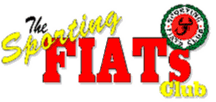Introducing
the Cinq
Hey just what do you expect to get out of a budget city car anyhow?
Well Fiat have a tradition of getting an awful lot out.
The Cinq is
amazing! Started life with a 45bhp version of the push rod Panda engine.
In '95 it got the larger FIRE
engine option of 1108cc shared with the Punto 55. Then the icing
on the cake arrived with the 54bhp Sporting. It almost makes traffic
jams fun.
Yes for the
purist it has to be the Cinq Sporting. It has the sparkle, and that
cheeky nippy small car attitude. 'Just Bite Me' would be a good slogan
for the attitude thing I think. Of course you'd have to catch it first!
But the story
doesn't end there. Cinq has a more refined big sister. Looks like she
does her shopping in the West End. From '98 we had more style and softer
cushions, different decor. She doesn't do nippy quite so hard. Her name
is Seicento.
Why do I always
picture her as half Spanish rather than all Italian? Ever dated sisters?
You know they're the same but different all at once. Try a drive in
both - you'll see what I'm getting at. Don't spend too long out there,
it might just change your life!
Cinquecento/Seicento History
Fiat put a lot of effort into designing their new 500 (Cinquecento is
five hundred in Italian). The project started in the mid 80’s
as one of Fiats famous ‘X’ code projects - X1/75 and then
X1/79.
8 styling exercises were commissioned by Fiat - The Bertone off road
spider, Boneschi a miniature cab, IDEA Institute 3 seater Grigua (lizard),
Zogato a bike carrying city car, ITCA a mini cabrio, Coggliola a mini
coupe. Ital design a people carrier.
It was introduced in Italy late in 1991, and launched in the UK at the
design exhibition in London in 1993. Cinqs were difficult to find in
the first few years and even held a price premium. By May 1995 there
were 18,000 on Brit roads. Prices started at £5254 then.
In Italy it was powered by either a 704cc sohv two cylinder (31bhp)
mounted horizontally, or a 903cc sohv four cylinder (41bhp) engine.
Both versions were available with catalysts, the 704cc unit using an
electronically controlled carburettor, the 903cc unit using fuel injection.
But we've never seen these engines in the UK - they were destined for
the eatern side of Europe in the main - where the cars were built.
In 1993 the
903cc unit was reduced in capacity to 899cc with 39bhp. The 899cc engine
is a more sophisticated version of the 903cc, and used in several other
models. Later versions had distributor-less ignition, to cut down on
maintenance.
Cinqs came in only one body style, a three door hatch back. It was built
at Tychy in Poland. Independent suspension all round, disc brakes at
the front and unassisted rack and pinion steering were common to all
models. If you avoid pedal-to-the-metal antics it has excellent fuel
consumption (up to 60mpg), aided by a drag coefficient of 0.33... excellent
for such a short car, and if combined with the very small frontal area
you get a good hint why these cars can reach 100mph.
Central locking, electric front windows, glass sunroof, and even air
conditioning were standard on some models, and optional on others. Cinqs
were galvanised on all external panels to avoid corrosion problems.
Crumple zones and side impact bars were included.
Later, in 1994, came the 'Sporting' with the 1108cc (54bhp) sohc FIRE
engine and suspension modifications (lowered by 20mm plus anti-roll
bar and stiffer shockers). Externally, it came in three colours –
red black or yellow, with colour coded bumpers and rear view mirrors.
Inside there was a rev-counter, drilled accelerator pedal, leather steering-wheel
and new 'sporting' seats.
In 1995 the second series was launched. External changes were minor,
mainly revised trim, options and colour coded plastic on some models.
Production finished in 1998, when the Seicento was introduced.
A rally version, the Cinquecento Trofeo, was built for a single-make
series, whilst later developments resulted in Group A and Kit versions.
An electric version, the Elettra, powered by batteries was made in small
numbers from 1992. This was a two-seater as the batteries occupy all
the space behind the front seats. The motor was a 13hp DC series wound
unit, and the total weight of the car went up to 1110kg. The Soleil
was also built, featuring a full length canvas sunroof – a throw
back to the days of the original Fiat 500 and 600.
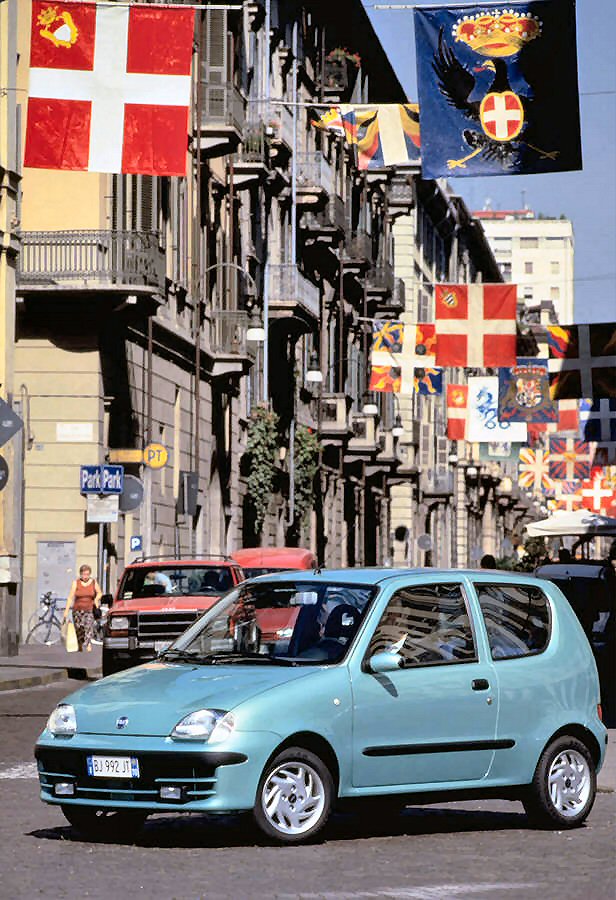
Seicento
The Seicento follows Fiat’s recent strategy of updating models
every six years. The main difference to the Cinq is its body styling.
It is also heavier with additional safety features available. The Seicento
has front seatbelt pretensioners, energy absorbing steering wheel, collapsing
steering column as well as airbag and ABS options.
It was available with either the 899cc ohv engine (in the S,SX and Citymatic
versions) with 39bhp. The Sporting has a 1108cc sohc FIRE
engine giving 54bhp. Electric power assistance for the steering
was an option. Fiat were much more alive to the modification potential
this time and the Sporting had a full range of 'Abarth' badged body
styling accessories.
The Citymatic featured an automatic clutch coupled with a conventional
5 speed manual transmission (has two pedals and a gear stick!) while
the Elettra version used an AC three phase motor powered by lead acid
batteries.
The Seicento Sporting features modified suspension (again with a front
anti-roll bar) and modified body trim. Internal trim changes included
a rev counter. It was given a facelift in 2000 with a new front bumper
and the adoption of the new round Fiat badge. At the same time the single
point injection systems on the 900 and 1100 engines were replaced with
multi-point injection.
To celebrate Schumacher winning the 2000 Formula 1 World Championship,
Fiat also produced a Michael Shumacher Limited Edition Seicento.
Early in 2004, on the arrival of the New Panda, the Seicento range was
cut back. Only the 1100cc engine with basic trim levels remained, other
versions – including the Sporting were withdrawn.
|
Bore
x Stroke |
|
|
| Cinq engines |
|
|
|
| 704cc |
(80x70mm) 2-cyl |
31bhp |
|
| 903cc |
(65x68mm) 4-cyl |
41bhp |
|
| 899cc |
(65x67.7mm) ~ |
39bhp |
17.7 secs* |
| 1108cc |
(70x72mm) ~ |
54bhp |
13.8 secs |
| Seicento |
|
|
|
| 899cc |
(65x67.7mm) ~ |
39bhp |
17.2 secs* |
| 1108cc |
(70x72mm) ~ |
54bhp |
13.4 secs |
| |
|
|
(*) = 0-62 or 0--100kph time |
Cinq Impressions
Driving controls are light and responsive. They're small but not claustrophobic
inside. There’s plenty of visibility – the large glass area
makes the interior feel a lot more spacious than it really is. It keeps
you in touch with the outside world and the car’s corners too.
That’s why one should be issued to every first time driver. Off
with the ‘L’ plates on with the Cinq. Of course Fiat are
famous for making driver’s cars. Forget the BMW ultimate driving
thing. The best Fiats have always been made for the driver first (rather
than the ego) – it’s genetic, in-bred, a fact of Fiat life
so obvious that long term owners tend to never mention it. You must
be able to FEEL the road and what the car is doing about it. You’ll
become aware of this through all your contact points with the car. Good
Fiats talk back to you the driver… (and they should fit you like
a glove - if they don’t you should do something about the seats
until they do)… And make no mistake this is a very good Fiat.
Forget all else you’ve heard about the first best mods for the
Cinq, either under the bonnet or around the car. I happen to be about
the right sizes to be Italian – Italian off-the-peg suits actually
fit me. And so do their cars. If you don’t fit well then change
the seats until you do.
The gear lever comes to hand and the 5 speed box ratios are well chosen.
It’s all efficient and highly maneuverable on the road. The Cinq
is light and very responsive through corners, confidence inspiringly
so. Inside the boot is small if the split folding back seat is up. You’ll
find many uses for the deep door pockets as well. You’ll also
find the insurance group a pleasant surprise too.
Sporting
Shootout
How do the UK spec Cinq and Seicento Sportings make out against each
other?
.
| |
Cinq
Sporting
|
Seicento
Sporting
|
Wheelbase |
2200mm |
2200mm |
front
rear
|
|
|
Engine |
1108cc sohc |
1108cc sohc |
Gearbox |
5 speed manual |
5 speed manual |
|
-
240mm
disc
185mm
drum
dual
hydraulic & servo
|
-
240mm
disc
185mm
drum
dual
hydraulic & servo
Bosch
ABS
|
Steering |
3.9 turns
rack & pinion |
3.9 turns
rack & pinion |
Rear Axle |
Cross beam with semi trailing
arms |
Cross beam with semi trailing
arms |
|
-
Macpherson
strut
Telescopic shocker & Coil Spring -
|
-
Macpherson
strut
Telescopic shocker & Coil Spring -
|
| |
13inch |
13 or 14inch |
| Kerb Weight |
735kg |
804kg |
| Max Power |
54bhp@5500 |
54bhp@5500 |
| Max Torque |
63lbs/ft@3250 |
63lbs/ft@3250 |
| Top Speed |
99mph |
97mph |
| 0-60 time |
13.7 secs |
13.4 secs |
| |
|
|
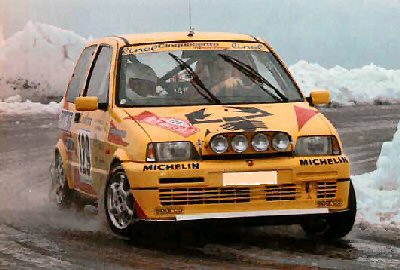
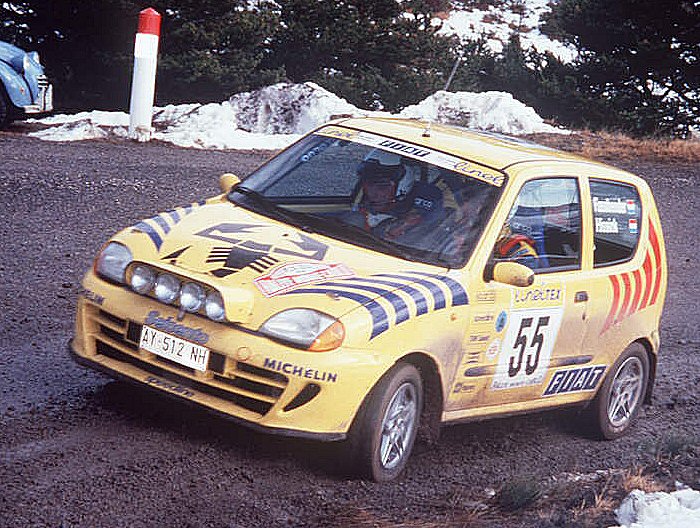
Buying Guide
General
Town cars that
take good mileage. There should be no reason why these cars can't reach
120,000 miles without too much fuss. But remember the ancillaries -
starter, alternator, shockers and springs, wiper motors and other electric
motors will be giving up around 80,000 to 90,000. Budget for replacements
Body
Town or City life can mean a lot of knocks and scrapes for these cars.
Check that there are no mismatching panels, large areas of discolouration
or signs of fresh paint. Although all the main body panels were galvanised
this may not apply to aftermarket replacements – best revealed
by looking behind interior trim on suspect panels. Welding upsets the
galvanic layer too.
Compare paint colour and finish on the inside the engine bay with the
external body colour.
Inspect the small diameter wheel rims (inner and outer) for signs of
kerbing and being pot-holed.
Check Cinq petrol tank – and documentation for replacement. It
was prone to splitting along front seam and was the subject of a more
recent recall notice.
Check for uneven tyre wear and driving straight (back wheels in line
behind front when on the move) – bent chassis/ subframe shows
quite easily.
Check for tracking in a straight line on a flat road on the test drive.
Suspect damage if steering input is needed.
Mechanicals
Run the engine
up to temperature, check the exhaust tail pipe for even pressured ‘blow’,
at tickover. While also listening for cam follower noise on the head,
not too quiet (seized?) or too noisy.
Check condition of the breather, oil filler cap and visible cam - look
for mayonnaise, or baked on heavy brown deposits (suspect too long between
oil changes) or off-white deposits (suspect heavy short journey use).
Check the gear change for clean engagement and smooth selection.
Check clutch operation, noise from friction plate springs and any grabbing
or slippage. Sprint starts can 'do for' the clutch springs on the friction
plate and pressure plate.
Check the clutch
cable for smooth operation and no signs of fatigue leads to heavy
feeling on the pedal and bills if possible to see how often its has
been replaced.
On tickover listen for excessive gearbox noise, (compare three cars
at least).
Check the main electrical functions - wipers, windows, lights, etc...
try putting the main beam and wipers on at the same time.
Check the headlights
for cracks.
Check the brake master cylinders - (the pedal shouldn't go to the floor
if pressed hard for a long time)
Check that the car tracks and brakes in a straight line under braking.
Check steering and cv/ ball joints with several lock to lock turns,
listening for any noises.
When moving listen for ticking speedo cables.
Lambda sensor failure is quite common on injection models. Check it.
A cambelt change is required at 63,000 miles Do it at 50,000 miles and
if in any doubt do it when you first get the car. Don't skimp on oil
and cam belts!
Check handbrake operation, inspect for seized rear calipers. Cinq has
always been 'blessed' with a dodgy handbrake - it needs regular cleaning
and Coppa slipping at the calipers, and greasing on the cable/ pullies.
A good test to see if enough effort has been put into maintenance.
Check alloys
for signs that they have been curbed and also check tyres for excessive
wear.
Other Notes
Listen for noisy wiper motor - some do this from new.
Check the car
keys - Make sure the car comes with the original RED key (on P or later
plates) as the Fiat dealer needs this (for its special master code)
when servicing the car.
The every day
ignition key is BLUE in colour (usually 2 with car). Replacements of
either are pricey. One key should open everything....
All Cinq's have a locking filler cap beneath the flap on the drivers
side. Check the Ignition key opens it.
FAQs
- Questions from the SFC Forum
Q
What options do I have
for getting new keys?
A http://www.sfconline.org.uk/forum/topic.asp?TOPIC_ID=413
Q
I have a 1998 cinq sporting .. it has done 41,000 should I be getting
the cambelt changed this service, or wait for 50k ... thanks as always
... JV
http://www.sfconline.org.uk/forum/topic.asp?TOPIC_ID=979&whichpage=1
A.
suppose I should have just fired you the facts off the Cinq/ Sei model
page
JV........ I've looked around the internet and I see why you are asking.....
Cambelt service change Fiat:
Cinq...........................72,000 mls
Cinq Sporting .............63,000 mls
using the 70% rule that's why people get confused
Cinq...........................50,000 mls
Cinq Sporting..............45,000 mls
if you don't rev it hard then by the guide above you can happily move
these figures by 5000 miles with little added risk, but after that the
odds increase.
The main reasons for increasing risk are over revving, too tight a tensioner
and a partially seizing tensioner, with contamination and improper storage
of the belt next (keep out of sunlight, don't hang up on nail by teeth).....
Guide prices (ex VAT):
Cambelt £15 - £18
Alternator Belt £5 - £7
Tensioner £16 - £20
Cam Cover Gasket £4 - £5
Parts pain on this car will come from the water pump, master cylinder,
and gear box. As Richard pointed out to me recently, the head gasket
should be tightened up using the Punto 55 figures - same engine different
numbers - in particular the main head bolts are tightened to 45nm not
40nm and that's why the Cinq Sporting head gasket has a tendancy (unlike
any other Fiat) to go at 45,000 miles.
Q
Why does the Cinq Sporting have a reputation for blowing its head gasket
at 40-50 thousand miles?
A
The head gasket should be tightened up using the Punto
55 figures - same engine different numbers - in particular the main
head bolts are tightened to 45nm not 40nm on the second torque down
and that's why the Cinq Sporting head gasket has a tendancy (unlike
any other Fiat) to go at 45,000 miles.
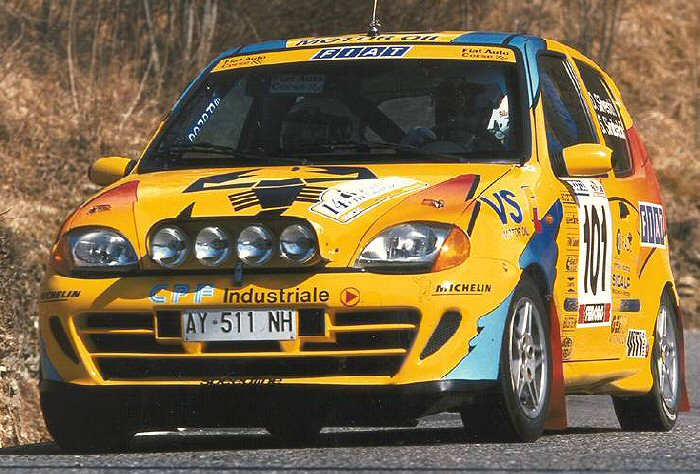
Recalls
The build quality of the cars are very good. This is reflected in the
low number of recall notices Fiat have sent out.
The ones we have found are listed below. Should your vehicle be one
which falls into the small numbers affected then 1) Check through your
service history to make sure the remedial action has not already been
attended to. 2) If you are uncertain then take your car to the nearest
dealer for advice.
The first two recalls here have almost certainly been completely dealt
with already by postal contact with the owners. The more recent fuel
tank recall is much less likely to have been dealt with and is not being
administered by post. Once again call your dealer for more advice, and
have your VIN: number to hand for reference.
Recall Notice 1
Model: Cinquecento S, SX and Soleil
Concern: Brake servo unit could become inoperative
Description of defect: After extended high speed running, brake
servo assistance may be lost due to petrol contamination of the servo
diaphragm.
Remedial action: The affected vehicles are being recalled for
replacement of the servo brake vacuum pipe and checking of the brake
servo efficiency, this will be adjusted to accord with the manufacturers'
specification.
Vehicle identification numbers: ZFA17000000862082 to ZFA17000000957625
VI reference: R1997/080
Recall launch date: March 21, 1997
Affected Car Build dates: November 1996 to April 1997
Numbers involved: 35
Recall Notice 2
Model: Cinquecento (non air bag)
Concern: Fracture of steering column weld
Description of defect: As a result of a manufacturing fault
the weld securing the steering column universal joint may fail.
Remedial action: Affected vehicles are being recalled for replacement
of the steering column shafts with quality assured units.
Vehicle identification numbers: 1081337 to 1086344
VI reference: R1998/13
Recall launch date: February 23, 1998
Car Build dates: November 1997
Numbers involved: 75
Recall Notice 3
Model: Cinquecento (all models)
Concern: Fuel Tank leakage.
Description of defect: Corrosion around welded seam of fuel
tank leading to fuel vapour leaks and ultimately fuel leakage.
Remedial action: Affected vehicles are being recalled for replacement
of fuel tanks with quality assured units.
Vehicle identification numbers: unknown, but most cars affected.
VI reference: unknown.
Recall launch date: November 1999.
Car Build dates: Virtually all production of S, SX, Sporting
and derivatives from start of production.
Seicento
Recall
Notice 1
Model: Seicento (all models)
Concern: Brake Pedal Fracture.
Description of defect: Wrong specification brake pedal could
eventually fracture in normal use.
Remedial action: Recall affected vehicles and replace brake
pedal with quality assured units.
Vehicle identification numbers: code offered 294228 to 302284.
292 vehicles affected.
VI reference: unknown.
Recall launch date: June 2000.
Car Build dates: Between July and August 1999.
Recall
Notice 2
Model: Seicento (all models)
Concern: Possible chafing of brake pipes.
Description of defect: Possible chafing of rigid front brake
pipes, at nearside front against the plastic wheel arch liner, or against
the gearbox mounting. Also at the offside front against the engine timing
belt cover.
Remedial action: Reposition any chafing brake pipe to comply
with manufacturers prescribed clearance between adjacent parts. Renew
any chafing brake pipe that has been chafed beyond serviceable condition.
Vehicle identification numbers: ZFA187000000001 to ZFA18700000192967
1084 vehicles affected.
VI reference: unknown.
Recall launch date: 7th December 2000.
Car Build dates: 1st January 1998 to 31st December 1999.
Manufacturer: Fiat Auto (UK) Ltd
Fiat House, 266 Bath Road, Slough, Berkshire, SL1 4HJ
(01753) 511431
Modification
(Please
note any of these changes are notifiable to your insurers and may invalidate
your insurance)
I’ve
read a lot of guff about the Cinq and Seicento and ‘just leaving
them as they are’. Like the Fiat 500 and 600 before them they
are begging for modification. “Carefully and tastefully done”
should be the watch words here.
First off make sure you are well seated and fit the driving seat well.
Choose the right option seats for you. Before embarking on lots of options
– lets look at a Fiat modification………
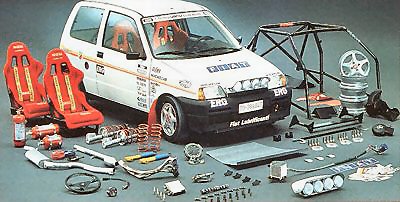
Seicento
Sporting Kit
Fiat had been slow to respond to the demand for tuning kits with the
Cinq. They made up for this with the Seicento. The factory offered a
Trofeo rally car derived kit
for the Sporting. The Seicento Sporting Tuning Kit was undoubtedly the
most potent of Fiat’s several tuning packages. With the engine
capacity increased marginally to 1146cc and the use of four 38mm throttle
bodies, it produced 128bhp @ 7,800rpm. With Uno Turbo ventilated front
discs and 227mm solid discs at the rear it also stopped better. The
suspension was fully rose-jointed, with a limited slip diff, six-speed
gearbox and all up weight of only 810kg. The kit cost 29000 Euro (in
2002). Perhaps the six speed box and lsd is a little excessive for a
road car. The Punto derived 6 speed box has a good spread of ratios
and if you can find a second hand one doesn’t take too much modification
to fit - providing it has the right casing and mounts there are three
variations out there, of which one is ideal for the Sei.
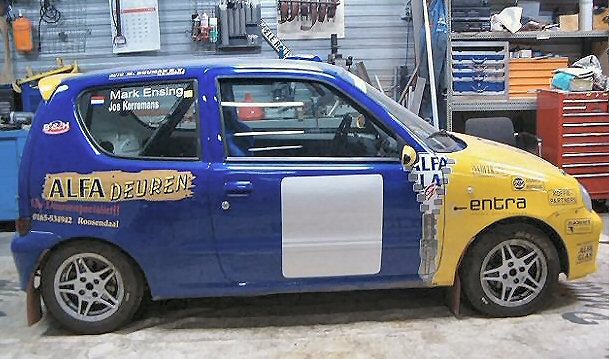
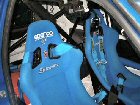
Engine Mods.
On older engines regular oil replacement with a good semi synthetic
oil is the recommended option. It offers better overall bearing protection
in low pressure designs like Fiat’s engines – rather than
the fully synthetics. Fully synthetic oils will offer better bhp from
less resistance, but also do less to support bearings and journals with
wear already present.
Larger injector
with the new ECU/module and camshaft, significantly improve the power
output.
Add a cold air intake, with a large diameter inlet pipe (minimum 5cm)
to duct air to the filter at the same time.
Further modifications can include gas flowing the cylinder head and
inlet manifold.
After completing all the above. Consider fitting an oil cooler for track
and high revving applications.
Unless nitrous
injection systems are being considered, larger valves tend to sacrifice
too much of the engine's mid range flexibility. Changes to small capacity
engines like these need to be kept in balance - and planned in unison.
Note that the
clutch needs uprating too. Friction plates and heavier pressure plates
will be required. Consider lightening the flywheel at the same time.
' Full House' Engine Modifications
For some of these options kits exist - in other cases they don't offer
much commercial gain for tuning firms and therefore are not as popular.
None are 'DIY' level mods. You will need professional level capability.
Setting a power
target. For the Cinq/ Sei, we would suggest an upper target around 120bhp
DIN. So parallel suspension and brake mods are essential. Refer back
to the spec of the Seichento Trofeo Kit again to see how this was achieved
by Fiat. This power output equates to around 170 bhp per ton in the
Cinq. Its also a stern tuning test - to extract 120 plus bhp from a
1108cc engine. So it will not be cheep to achieve and it is important
that any professional suport you obtain can show a successful track
record in obtaining these power levels for sustained mileages from previous
clients.
Main Engine options:
Modify original
Capacity increase, new profile cam, followers and head rebuild. Competition
head gasket. 38mm throttle bodies and new injectors, ECU, fuel regulation,
extractor manifold and straight through exhaust system. The single point
injection design on Sei Sportings before 2001 provide a good starting
point for tuning.
Turbo kit
Install a turbocharger. The problem with adding a turbo to such a small
capacity and small port engine is the heat created inside the chambers.
This translates into short engine life... or reduced boost. Early kits
had the compression ratio dropped to around 8.2:1 (from the standard
9.6:1) and a boost of 0.8 bar. Later examples have used more like 7.8:1
and 0.6 bar from something like a medium sized Garrett turbo - for example
a T2. And a Uno Turbo sized intercooler, turbo pistons and new ECU with
matching injectors & injection module, can produce between 110bhp
and 120bhp. The problem for this tuning route is the expense of going
to turbo capable pistons and the rest of the kit to achieve power and
torque outputs very similar to tuning a normally aspirated version.
Head preparations
- the compression ratio should be reduced by machining the chamber shape
for higher turbo air velocities around the valves. The head has enough
material to convert the normally aspirated chamber shape into a 'heart'
or 'mickey mouse head' shape. A larger inlet valve is not necessary
but helps. It is more important, for increased torque, to increase the
duration that the valves are open, and bring their static timing forward....
this then requires a different camshaft!
To
give you an idea of the difference in cam lobe position, take the 1290cc
X1/9 or 128 3P of the late seventies - this famously hard revving
engine had cam timing of 12/52/52/12, (with 9.75mm valve lift) while
the same capacity and similar design engine in the Uno Turbo
1301cc had 0/40/30/10 (with 8mm lift) and later Mk2 turbo cam
of 14/44/36/6 with (8.8/9.5 i/e lift). Every turbo installation in the
Fiat range follows a similar pattern increased lift and duration.
Pistons
- your choice of piston will
dictate the boost possible. Unfortunately, although higher quality pistons
are available they cost more! If a turbo kit retains the stock pistons
then it is probably not able to run more than 0.4 bar boost without
reducing engine life. Leave the stock pistons alone, and pocketing for
increased valve lift is not recommended..... so the higher lift is limited
too. The stock pistons will suffer from heat damage and blow-by if higher
boost is used, simply melting or causing little end failure.
Fiat's
turbo solution was to provide better quality pistons and re-design of
their piston rings. But an additional trick in the Uno T is to provide
an oil jet/spray directed at the piston skirts at bottom dead centre.
Pistons thus cooled
increase the engine's life. Again its another difference between the
after market kit and manufacturer designed solution.
Head Gaskets
- thicker competition gaskets and Spesso competition gaskets are available.
ECU &
Injection - options do not change with the Turbo kits. I've seen
modified standard ignition packs and OMEX 2D maps used to successfully
help drive a turbo installation.
Every thing
in the engine bay also needs screening against the additional heat.
Fit other Fiat engines
Best candidate is the 1242cc 16-valve Punto Sporting FIRE engine. Its
a light compact twin cam - and the block is not ridiculously taller
in the Cinq engine bay. It comes with nearly 80bhp as standard and uses
a similar design of diff and box. Tuning potential is better - I mean
120bhp is more easily achieved for less money.
Ease of fitment
depends upon careful choice of components and does not
drop straight in. There are three versions of Punto boxes availableSeveral
projects have tried and unfortunately not used the same route. Cleanest
should be using all the 1242cc components possible - including the box
and diff, connecting/using the Cinq originals at the drive shafts. The
lock will suffer a little doing this. Pay attention to limiting the
front/rear block movement with a stabiliser bar as some key components/
pipes come close to moving metal edges in the engine bay (this is another
reason to favour sticking with a normally aspirated tuning solution
with these bigger engine blocks).
But this FIRE
engine is over-size and doesn't quite fit the standard subframe. The
Punto boxes mostly come with hydraulic clutches as does the 6 speed
Punto we would favour (if you can source one). The hydraulic clutch
action can be converted to cable using a combination of early Punto
and Cinq components. Then there's the exhaust system to slot in as well.
Finishing with
a ported & re-shaped head plus injection/throttle bodies and a fully
re-mappable managment system should reliably deliver about 120bhp.
Does the
1264cc (16-valve) head fit on the 1108cc block? Bore sizes are
too different really. I'll need to check and think on this one. Any
evidence should help.
The turbo options
present nasty heat problems in such a small engine bay; the Punto GT
is heavier larger taller and hotter - this means the 1264cc route problems
times about 10. Uno turbo same design as Punto GT - 1264 problems times
5.
Nitrous
Injection
Promising -
but we haven't seen any in use for three years after installation without
needing new pistons yet! Also they've yet to crack the 120bhp before
melt down. Remember heat from more power and piston life are inversely
related. Please inform us of any more promising candidates.
Clutch and Brakes.
Increasing the power output by apparently small numbers of bhp is actually
making large percentage improvements in power and torque. Heavier duty
friction plates and pressure plates for the clutch will be needed.
Brakes – look again at the Trofeo rally car spec. Ventilated Uno
Turbo front discs and solid rear discs were used. With this thickness
of disc, the Uno turbo calipers can be used, although brackets to mount
the caliper are different. The Uno Turbo’s brake set up works
well. Kits are available. Four pot systems tend to need more fluid to
operate, and therefore pedal travel is much further. Steel braided brake
hoses are also advisable – as they will retain a more consistent
feel and pedal pressure during their life.
Brake bias valves (under other names) have been fitted to most of the
small and medium sized Fiat road saloons for the last twenty years.
Some are externally adjustable (like the later 128s). They are fitted
as load/rear brake compensators if the boot or hatch area is heavily
laden. Alternatively you may desire an after market brake bias valve.
Suspension.
Lowering the roll centre of these cars is probably a good idea. Sportings
start 20mm lower to begin with. Problem with lowering by another 40mm
and beyond on such a small light car is that you lose most of the available
suspension travel. To compensate spring rates are increased to avoid
bottoming out, or for that matter the bottom coming out when ‘slamming’
into multi story car park floors etc – thus you end up riding
a go-cart. This doesn’t do you or the drive shaft and suspension
arms any favours either. Bringing the chassis down another 20-30mm appears
to be a happy medium. Its also a shame if all the notable investment
by Fiat to make the standard sporting suspension feel like a larger
car is completely lost.
If the right type of coil-over set up is used on the front, longer ‘rising
rate’ springs can be fitted that give an increasing stiffness
as they compress. This can give a better ride around town but stiffens
over bumps or during high speed body roll. But its an expensive route.
Suppliers like Jamex have specialised in providing rising rate springs
for standard shock absorbers. These springs are lower and provide about
20% stiffer spring resistance, combined with 20mm height reduction,
but in the first few millimetres of travel have near standard bump resistance.
This means you can drive around town with near standard feel suspension,
but when cornered faster the siffness of the spring increases with greater
suspension travel. Try spring only changes like these first if you have
doubts about losing ride comfort - its cheeper.
What's the
maximum? Probably the limit/ best compromise is to stick with the standard
shockers and drop the car no more than -50mm. Novitec and Eibach both
do spring sets for this ride height which are stiff but not riduculous
(Eibach are noticeably the stiffer of the two). Stiffer springs like
this and heavy track day use may mean you eventually need to reinforce
the suspension top mounts - especially on the rear. Don’t forget
there are different thickness anti roll bars around too if you get serious
about tuning the handling side.
Fitting replacement nylon bushes to provide more accurate suspension
and wheel movement in place of the standard items is in our experience
useful, at the expense of more noise and vibration. But we have detected
little difference in chassis rigidity from front and rear strut braces
when fitted.
When selecting wheels and tyres, it is recommended that the Seicento
Sporting front track is established (slightly wider than the Cinq).
Having a slightly wider front track yet keeping the rear track standard
appears to improve the responsiveness through fast corners. Don't go
'over the top' though.
Other Mods
It is possible to fit the six speed gearbox from the Punto into the
Cinq. giving closer ratios (sixth gear is almost the same as the standard
Cinq fifth). Installation of a quicker steering rack is very desirable.
3.9 turns lock to lock is too much for track work. There are now several
options available for Cinq 'quick' racks.
Project:
Seicento Sporting
into 600M: http://www.sfconline.org.uk/forum/forum.asp?FORUM_ID=22
SFC
Gallery

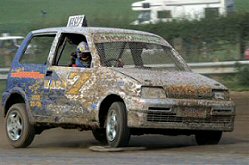 ..
..
........................................................................................................................................
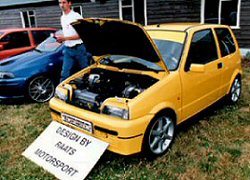
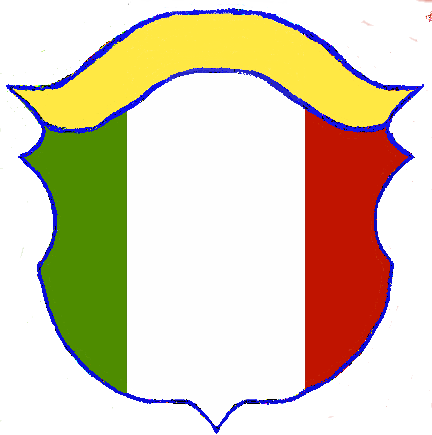

http://www.sfconline.org.uk/forum/topic.asp?TOPIC_ID=429
Links
Clubs and Interest
Roger Gill
and co have been having autograss fun in the Yorkshire
Dales with their Cinq. He's switched from being a total Imp man,
but I'm still looking for a pik of the new Cinq from 2004 on their site!
Here's one for the Gallery.
Parts and
Tuning
Why
do you feature so many German tuners for Italian cars? They
generally offer very high consistent quality products that have to pass
the TUV requirements (MoT/safety & emissions tests in Germany) on
the car specified. The Italian road tuning options have also suffered
in the last twenty years since road cars have strictly limited changes
allowed by Italian law. Basically if its new and modified in Italy it
has to be used for motorsport only.
Wolf
Direct Racing Beccles (nr Norwich) based Cinq and Seicento specialist
tuners, builders of the 500M and 600M Centos 07738 641317. Very capable
shame they do Jags as well!
G.S.R.
Engineering based in the Essex side of London, have been expanding
their tuning range in recent years, and stock a wide range of spares
and tuning options. In depth knowledge of the FIRE engine.
Middle Barton Garage at
Chipping Norton near Oxford. Abarth and 500/600 specialist with modifications
and Abarth parts for the Sporting. Very much in the Abarth tradition
very capable.
Van Aaken Developments Located
at Crowthorne, Berkshire and offering many tuning options from simple
ECU chip changes to a 120hp Turbo conversion for the Cinq/ Sei.
Body and
Tuning Kits
Merkur
in Bamberger Str. 61 96215 Lichtenfels. Deutschland. Tel: 09571/5007
(add German international code)
A German Tuner who has lots of goodies to add to your Cinquecento from
body kits to engine conversions and everything in between Merkur have
it in abundance.
Hörmann Motorsport
Kempten (Germany) U.K. Dealer: Racing Brands of Pangbourne Berkshire.
Located in Germany Hormann offer several types of body kit, tuning packages
(including 100hp Turbo), tinted rear light clusters, coloured speedo
dials, suspension etc. Get their catalogue too.
Novitec Automobile Hochstraße
8 87778 Stetten (English agent : Forza Tuning, St Leonards Rd, NW10
6ST Tel: 0208 8386320)
Innovative and stylish options - a reputation for very well thought
through body and tuning options. Springs and Air Box come recommended
for the Cinq.
Postert Design for styling and
wheels - ESSEN (Germany)
Koester Motorsport one of the first to offer a 1.2 Punto engine transplant.
R.G.S. Motorsport Unit 72, Lawrence Road Ind Est, Wellingborough, Northants.Tel:
01933 441451 Abarth style body kits and on site rolling road.
Parts
Dalhems after market parts supplier
Sachs BOGE suspension site
HR Springs handling components
Power Alfa After market parts
supplier
Body kits from Autotint Design
Forza
Tuning body kit retailers including Cadamuro and Novitech
Power Fiat after market
parts
Longlife
offer tailored stainless steel exhausts
Alternative
Component Suppliers
This is one
I know we're going to regret - coz of the updating needed. So everyone
help keep it updated.
Its a quick
look directory of main aftermarket suppliers for the Cinqs.
| Supplier |
Suspension |
Springs |
Strut Brace |
Air Filter/
Box |
Exhaust |
Website
|
| Koni |
• |
|
|
|
|
|
| Eibach |
• |
• |
• |
|
|
|
| Bilstein |
• |
|
|
|
|
|
| Leda |
• |
• |
|
|
|
|
| Spax |
• |
• |
|
|
|
|
| Avo |
• |
|
|
|
|
|
| OMP |
• |
• |
• |
|
• |
|
| Hormann |
• |
• |
|
• |
• |
|
| Novitech |
• |
• |
|
• |
• |
|
| K&N |
|
|
|
• |
|
|
| ITG |
|
|
|
• |
|
|
| Jamex |
|
• |
• |
|
|
|
| Sparco |
|
• |
• |
• |
|
|
| Pi |
• |
• |
|
|
|
|
| |
|
|
|
|
|
|
| Janspeed |
|
|
|
• |
• |
|
| Powerflow |
|
|
|
|
• |
|
| Supersprint Ansa |
|
|
|
|
• |
|
| Jetex |
|
|
|
|
• |
|
